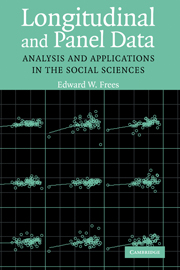Book contents
- Frontmatter
- Contents
- Preface
- 1 Introduction
- 2 Fixed-Effects Models
- 3 Models with Random Effects
- 4 Prediction and Bayesian Inference
- 5 Multilevel Models
- 6 Stochastic Regressors
- 7 Modeling Issues
- 8 Dynamic Models
- 9 Binary Dependent Variables
- 10 Generalized Linear Models
- 11 Categorical Dependent Variables and Survival Models
- Appendix A Elements of Matrix Algebra
- Appendix B Normal Distribution
- Appendix C Likelihood-Based Inference
- Appendix D State Space Model and the Kalman Filter
- Appendix E Symbols and Notation
- Appendix F Selected Longitudinal and Panel Data Sets
- References
- Index
10 - Generalized Linear Models
Published online by Cambridge University Press: 05 September 2012
- Frontmatter
- Contents
- Preface
- 1 Introduction
- 2 Fixed-Effects Models
- 3 Models with Random Effects
- 4 Prediction and Bayesian Inference
- 5 Multilevel Models
- 6 Stochastic Regressors
- 7 Modeling Issues
- 8 Dynamic Models
- 9 Binary Dependent Variables
- 10 Generalized Linear Models
- 11 Categorical Dependent Variables and Survival Models
- Appendix A Elements of Matrix Algebra
- Appendix B Normal Distribution
- Appendix C Likelihood-Based Inference
- Appendix D State Space Model and the Kalman Filter
- Appendix E Symbols and Notation
- Appendix F Selected Longitudinal and Panel Data Sets
- References
- Index
Summary
Abstract. This chapter extends the linear model introduced in Chapters 1–8 and the binary dependent-variable model in Chapter 9 to the generalized linear model formulation. Generalized linear models (GLMs) represent an important class of nonlinear regression models that have found extensive use in practice. In addition to the normal and Bernoulli distributions, these models include the binomial, Poisson, and Gamma families as distributions for dependent variables.
Section 10.1 begins this chapter with a review of homogeneous GLMs, models that do not incorporate heterogeneity. The Section 10.2 example reinforces this review. Section 10.3 then describes marginal models and generalized estimating equations, a widely applied framework for incorporating heterogeneity. Then, Sections 10.4 and 10.5 allow for heterogeneity by modeling subject-specific quantities as random and fixed effects, respectively. Section 10.6 ties together fixed and random effects under the umbrella of Bayesian inference.
Homogeneous Models
This section introduces the generalized linear model (GLM) due to Nelder and Wedderburn 1972G); a more extensive treatment may be found in the classic work by McCullagh and Nelder (1989G). The GLM framework generalizes linear models in the following sense. Linear model theory provides a platform for choosing appropriate linear combinations of explanatory variables to predict a response. In Chapter 9, we saw how to use nonlinear functions of these linear combinations to provide better predictors, at least for responses with Bernoulli (binary) outcomes. With GLMs, we widen the class of distributions to allow us to handle other types of nonnormal outcomes.
Information
- Type
- Chapter
- Information
- Longitudinal and Panel DataAnalysis and Applications in the Social Sciences, pp. 350 - 386Publisher: Cambridge University PressPrint publication year: 2004
